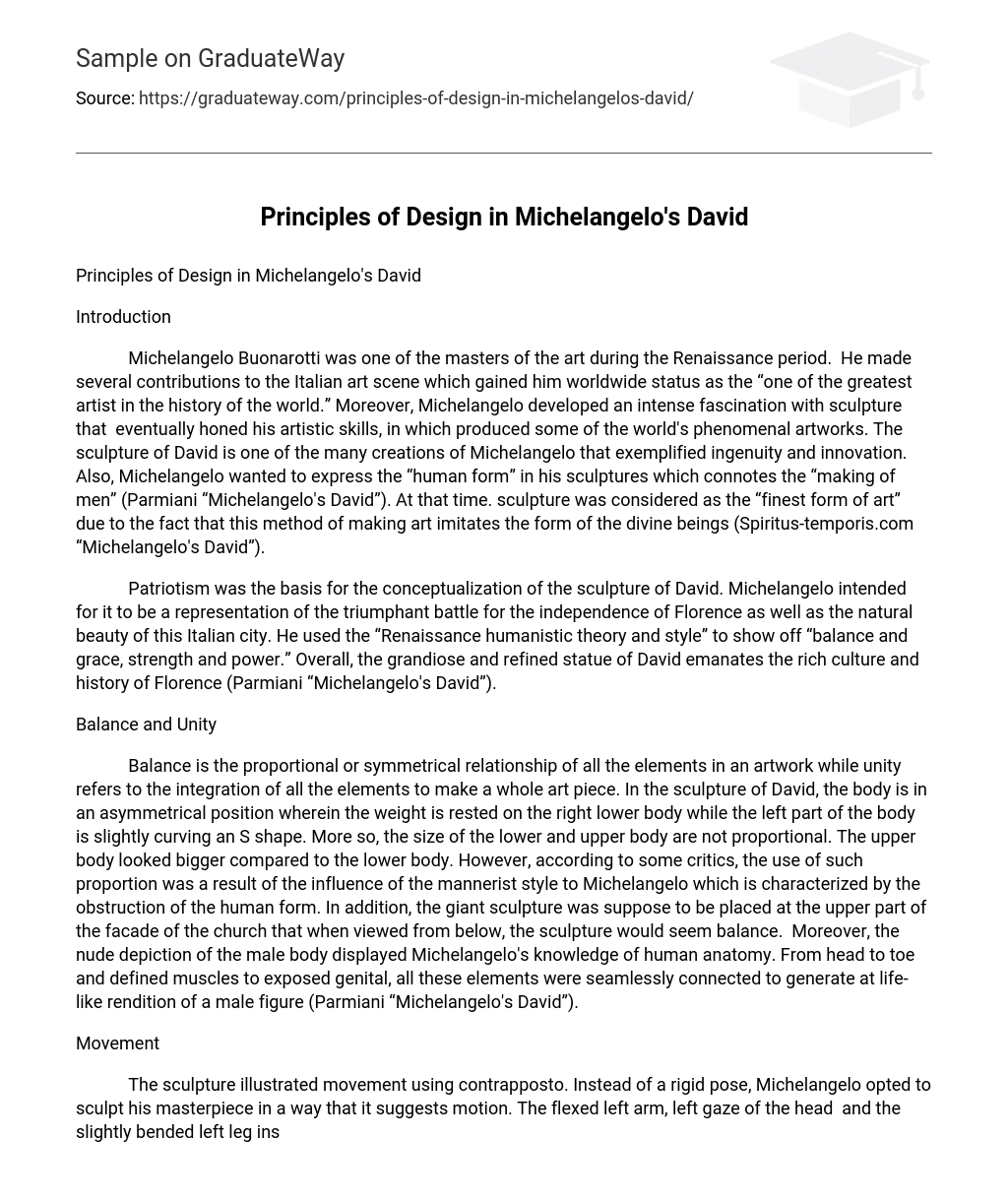Introduction
Michelangelo Buonarotti was one of the masters of the art during the Renaissance period. He made several contributions to the Italian art scene which gained him worldwide status as the “one of the greatest artist in the history of the world.” Moreover, Michelangelo developed an intense fascination with sculpture that eventually honed his artistic skills, in which produced some of the world’s phenomenal artworks. The sculpture of David is one of the many creations of Michelangelo that exemplified ingenuity and innovation. Also, Michelangelo wanted to express the “human form” in his sculptures which connotes the “making of men” (Parmiani “Michelangelo’s David”). At that time. sculpture was considered as the “finest form of art” due to the fact that this method of making art imitates the form of the divine beings (Spiritus-temporis.com “Michelangelo’s David”).
Patriotism was the basis for the conceptualization of the sculpture of David. Michelangelo intended for it to be a representation of the triumphant battle for the independence of Florence as well as the natural beauty of this Italian city. He used the “Renaissance humanistic theory and style” to show off “balance and grace, strength and power.” Overall, the grandiose and refined statue of David emanates the rich culture and history of Florence (Parmiani “Michelangelo’s David”).
Balance and Unity
Balance is the proportional or symmetrical relationship of all the elements in an artwork while unity refers to the integration of all the elements to make a whole art piece. In the sculpture of David, the body is in an asymmetrical position wherein the weight is rested on the right lower body while the left part of the body is slightly curving an S shape. More so, the size of the lower and upper body are not proportional. The upper body looked bigger compared to the lower body. However, according to some critics, the use of such proportion was a result of the influence of the mannerist style to Michelangelo which is characterized by the obstruction of the human form. In addition, the giant sculpture was suppose to be placed at the upper part of the facade of the church that when viewed from below, the sculpture would seem balance. Moreover, the nude depiction of the male body displayed Michelangelo’s knowledge of human anatomy. From head to toe and defined muscles to exposed genital, all these elements were seamlessly connected to generate at life-like rendition of a male figure (Parmiani “Michelangelo’s David”).
Movement
The sculpture illustrated movement using contrapposto. Instead of a rigid pose, Michelangelo opted to sculpt his masterpiece in a way that it suggests motion. The flexed left arm, left gaze of the head and the slightly bended left leg insinuated movement. These positions were accentuated by curves which outlined the entire human form in order to show mobility.
Pattern and Emphasis
The common element utilized by Michelangelo which was evident in the sculpture of David was the refined and naturalistic depiction of the muscles. The pectoral and the abdomen muscles were the most well-defined area of the body which exhibited the athletic nature of David. Also, these pattern of well-made or well-sculpted details made the sculpture stand out from the rest during the Renaissance period which was carried on to the contemporary era. Meanwhile, the emphasis of the entire sculpture was set on the naked body of David which imparts the notion of “power and stature.” Also, it demonstrates the subject’s heroism. More so, Michelangelo “saw the interior character of man reflected in his exterior body and, thus, expresses the moral state of this famous figure’s soul” (Lee “Gender identity in Michelangelo’s sculptures).
Rhythm
Rhythm in sculpture is expressed through the pattern of well-defined muscles and the curves of the lines of the body. The block of white marble was sculpted by Michelangelo to produce a perfect and smooth form of bodily strength and a fluid of lines strewn all over the figure. The combination and repetition of these two elements emphasized movement and harmony of a single subject.
Contrast
Contrast is evident on the treatment of the lower body and the upper body. At the upper part of the human figure, an elaborate set of details can be seen such as the lush hair, stern facial features and fully developed nude torso while the lower body is only accentuated by the male genitalia and the unbalanced feet posture. The contrast of the main features of the human figure highlighted the difference of the elements that made the classic sculpture more interesting and more elegant.
Conclusion
The sculpture of David is a widely celebrated artwork because of its accurate portrayal of the human body and the direct representation of David’s bravery through his posture. The different principles of design namely: balance, unity, movement, pattern, emphasis, rhythm and contrast have all contributed to the actualization of Michelangelo’s vision of showing to the world the immense and unique talents of the Florentines in conceptualizing and constructing iconic masterpieces.
Works Cited
Lee, Crystal. 2006. “Gender identity in Michelangelo’s sculptures.” Geocities.com. 22 July 2008 ;http://www.geocities.com/Vienna/Choir/4792/davidm.html;.
“Michelangelo’s David.” 2005. Spiritus-temporis.com. 22 July 2008 <http://www.spiritus- temporis.com/michelangelo’s-david/;.
Parmiani, Floria. “Michelangelo’s David.” 6 June 2008. Floria Publications. 22 July 2008 <http://www.floria-publications.com/italy/italian_culture/michelangelo_david.html>.





